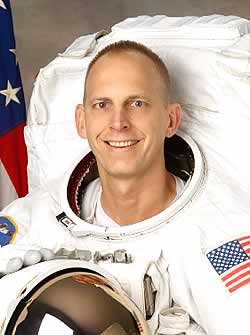RSC
Energia bio
(Oct 07) |
 Clayton
C. ANDERSON Clayton
C. ANDERSON
ISS Flight Engineer-2,
NASA Astronaut, USA,
DATA AND PLACE OF BIRTH:
Clayton Anderson was born February 23, 1959 in Omaha, Nebraska, USA
but considers Ashland, Nebraska to be his hometown.
Mother, Alice J. Anderson, resides in Ashland, Nebraska.
Father, John T. Anderson, is deceased.
EDUCATION:
Graduated from Ashland-Greenwood High School, Ashland, Nebraska, 1977;
received a bachelor of science degree in Physics from Hastings College
in 1981 and a master of science degree in Aerospace Engineering from Iowa
State University in 1985.
FAMILY STATUS: Married.
Wife: Susan Jane Harreld of Elkhart, Indiana.
Son: Cole Clayton.
Daughter: Mary Sutton.
HONORS:
Honorary Doctorate Degree from Hastings College (2004); NASA Quality
and Safety Achievement Recognition Award (1998); JSC Certificate of Commendation
(1993); Outstanding Young Man of America (1981, 1985, 1987).
HOBBY: Participation in all sports; flying; reading; writing music;
playing the piano/organ, vocal performance. When he studied at College
and High School he was a member of College and High School basketball team.
As an undergraduate he competed on the football, basketball and track teams.
NCAA National Christian College Basketball Championships Official (1997,
1998).
WORK EXPERIENCE:
In 1983 Anderson joined the Johnson Space Center in the Mission Planning
and Analysis Division where he performed rendezvous and proximity operations
trajectory designs for early Space Shuttle and Space Station missions.
In 1988 he moved to the Mission Operations Directorate (MOD) as a Flight
Design Manager leading the trajectory design team for the Galileo planetary
mission (STS-34) while serving as the backup for the Magellan planetary
mission (STS-31).
In 1989 he was chosen supervisor of the Ascent Flight Design Section,
the Flight Design and Dynamics Division.
In 1993 Anderson was assigned as the Chief of the Flight Design Branch
(mathematical software).
From 1996 until his selection Anderson held the post of Manager, Emergency
Operations Center, NASA Johnson Space Center.
In June 1998 he was enlisted in the astronaut team, NASA, as mission
specialist.
In 1998 he passed a full course of general space training. In August
1999 he got qualification as mission specialist and was appointed to Astronaut
Office, NASA. Anderson served as an ISS Capsule Communicator (CAPCOM) during
the Space Shuttle flights. He was the Crew Support Astronaut for ISS Expedition
4, providing ground support on technical issues and organizing the crew
talks with families.
Later he served as the lead for the Enhanced Caution and Warning System
development effort within the Space Shuttle Cockpit Avionics Upgrade Project.
In November 2002, Anderson completed training in the Extravehicular
Activity (EVA) Skills Program.
Anderson passed training as back-up Flight Engineer-2 for Expeditions
12, 13 and 14 to the ISS. In June 2006 he was assigned to Expedition-15
crew (ISS-15).
Initially it was proposed that Anderson shall fly as a member of STS-118
crew but because of the Shuttle flight schedule change on April 26, 2007
he was transferred to STS-117 crew.
On June 9, 2007 he performed his first spaceflight as mission-5 specialist
aboard Atlantis (STS-117); Atlantis/ISS docking occurred on June 10. Having
replaced Sunita Williams, Clayton Anderson is currently performs a flight
to the ISS as ISS-15/16 flight engineer-2. It is supposed that he will
make a landing aboard Discovery (STS-120) at the beginning of November
2007. 7 November 2007 151 days 18 h, 23 min.
October 2007
Based on data of the Cosmonautics News journal and
Lyndon B. Johnson Space Center, NASA, USA. |
|



 Clayton
C. ANDERSON
Clayton
C. ANDERSON